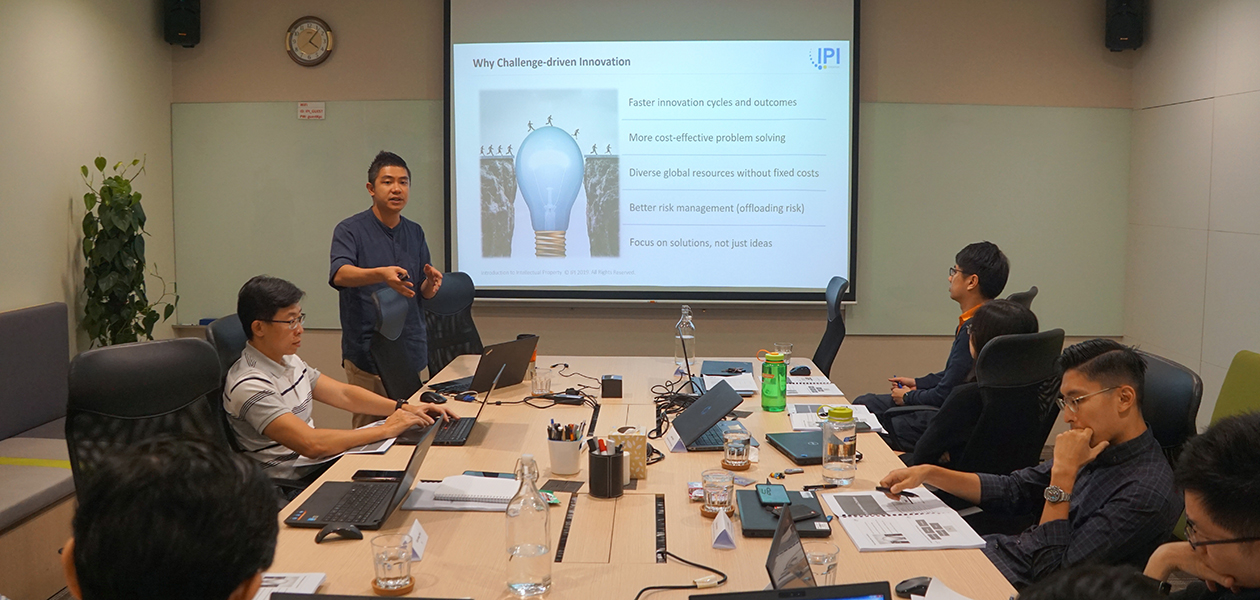Driving open innovation with clear problem statements
Learn how to craft useful and practical problem statements for challenge-driven innovation at IPI's next Open Innovation Workshop in October 2019
It’s been said that “necessity breeds innovation”. Yet, defining necessity can be a challenge in itself. For companies keen on executing a strategy of open innovation, figuring out what needs to change, or what should be improved to gain a competitive edge in the markets, is the first step towards throwing open the doors to collaborators and innovation partners.
“The framework ‘challenge-driven innovation’ consists of three key steps which can be remembered with the acronym IPI—Identify the problems, Pilot the challenge, and Implement and measure the impact,” said Alvin How, senior technology manager at IPI, during a session at IPI’s inaugural Open Innovation Workshop in April.
He went on to share some of the best practices involved in crafting effective problem statements, which could help delegates clearly identify and articulate the pain points and innovation objectives in their organisations.
Setting the boundaries
“Without a good problem statement, you'll never get the right solution,” How quipped, paraphrasing Wally Davis, director of web services firm Capterra, who once said that “A problem well stated is half solved.”
More than just the product of a thought exercise, a problem statement can be viewed as a contract between a company’s senior management and the team that is tasked with sourcing for novel technical solutions, said How. Depending on how broad or narrow the problem statement is defined, the number and quality of crowdsourced solutions can vary tremendously.
A broad problem statement is akin to casting a wide net, How explained, noting that such statements are generally more exploratory in nature, with fewer restrictions on the type or form of the solutions being sought. “The advantages of a broad problem statement are that you leverage a wide base of external sources for solutions, and so you typically receive a larger number of responses,” said How. But quantity is no assurance of relevance, so out of a hundred responses to a broad problem statement, only a few may actually be feasible for implementation.
In contrast, a narrow problem statement is one that is more precise in terms of requirements. Sometimes, the solution specifications can even be modelled after known technologies already on the market, requiring only minor tweaks or adaptions to become fit-for-purpose, How explained. The number of responses will shrink considerably when one puts out a narrow problem statement, cautioned How, but each proposed solution is likely to be highly relevant to the problem that needs to be tackled.
“Once you manage to find a balance between broad and narrow problem statements, you’ll get a good mix, in terms of the number of solutions, as well as their relevance,” How said.
The ‘5W1H’ approach
Regardless of whether one is crafting on a broad or narrow problem statement, How recommends using the ‘What, Who, Why, Where, When and How’ approach to make sure that no essential information is left out in the call for solutions.
Besides thinking about ‘what’ the problem is, technology seekers should also explore ‘what’ existing solutions are available and consider the impact of potential solutions to the organisation.
Just as important are the people affected by the problem—the ‘who’ aspect of the problem statement, How said.
Technology seekers should also identify ‘why’ and ‘where’ the problem exists, perhaps singling out a process or department that is experiencing friction. In addition, timeliness is a crucial element of innovation in ever-changing market conditions, so ‘when’ a solution can be ready must also be defined well.
“How urgent is the solution needed? If it is a matter of high urgency, then you need to change your approach—you cannot be looking all over the shop for a solution [using a broad problem statement],” he noted, adding that “this is where we need to decide on the technology readiness level, or TRL, of solutions that we want to entertain.”
Last but not least, How emphasised the need to know ‘how’ a solution works, as well as ‘how’ it ought to fit into the overall scheme of a company’s operations. With all these elements in place, the final problem statement is likely to fall somewhere between the extremes of broad and narrow, he said.
Should companies, academics and technology transfer officers be interested to learn more about open innovation strategies and best practices, they are welcome to sign up for IPI’s next Open Innovation Workshop, which will take place from 3 to 4 October 2019.

